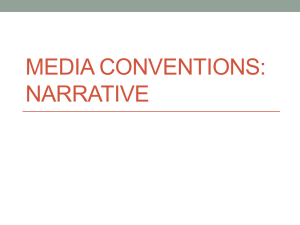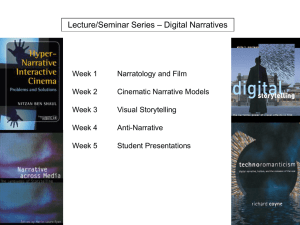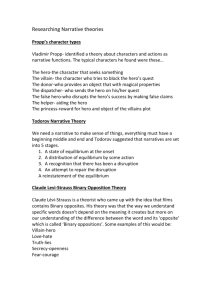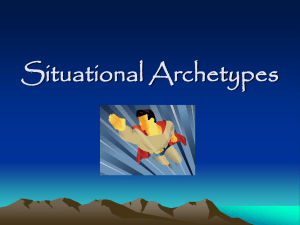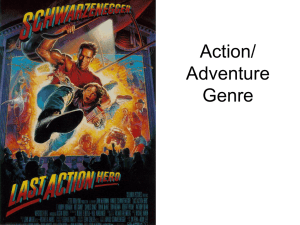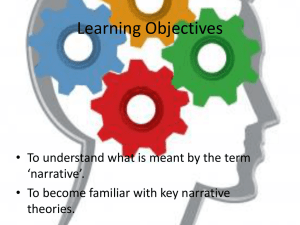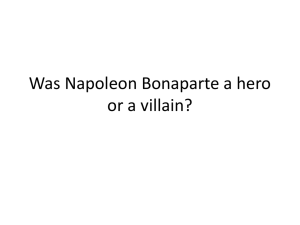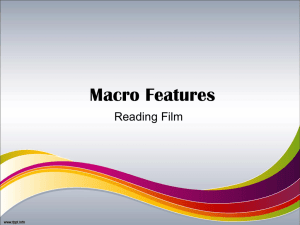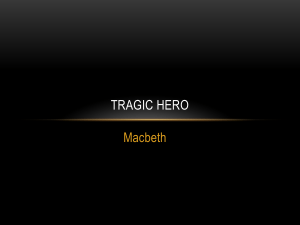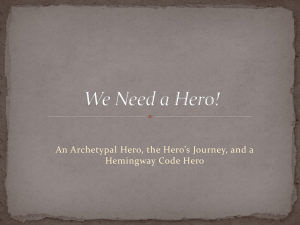- Kathleen Ahrens
advertisement
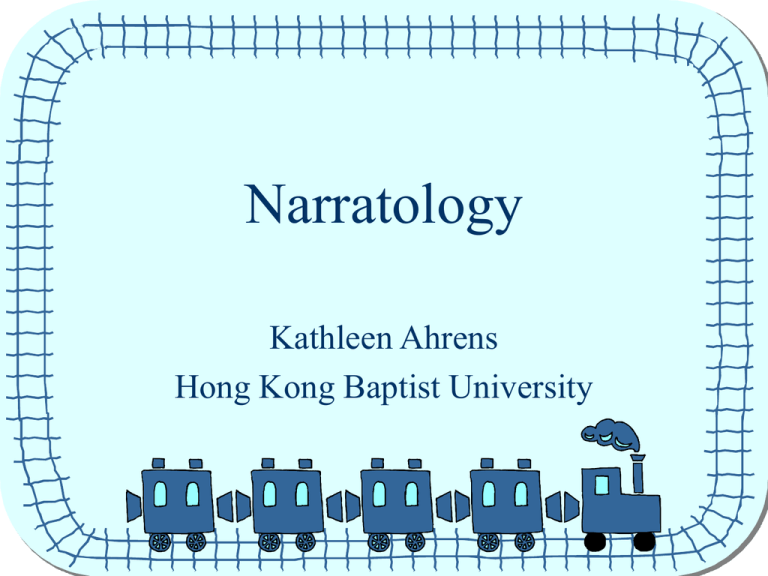
Narratology Kathleen Ahrens Hong Kong Baptist University How a story is structured • Narrative Structure – Characterization – Plot • Visual Structure – Color – Shape – Position Telling a story • Think of a story that is important to you – – Meeting your partner – Giving birth – Accomplishing a goal You as the storyteller • Pick one story • Imagine yourself telling this story to: – Your child – Your best friend – Your boss Analyze your stories • • • • • How did the story change? Where did you begin? Where did you end? How many details did you add? How much personal information did you reveal? What is Narratology? • Refers to the structuralist study of narrative • How recurrent elements, themes, and patterns yield a set of universals that determine the makeup of a story • Goal: To move from a taxonomy of elements to an understanding of how these elements are arranged in actual narratives, fictional and non-fictional Intellectual Tradition • Linguistic work of Ferdinand de Sassure (1857-1913, Swiss linguist) • Distinguished between parole (specific instances of spoken language) and langue (the idealized abstract grammar) Structuralism • The study of systems or structures as independent from meaning (field of semiotics) Roman Jakobson (1896-1982) • Russian formalist • Demonstrated how literary language differed from ordinary language Claude Lévi-Strauss (1908-2009) • French anthropologist • He concluded that myths found in various cultures can be interpreted in terms of their repetitive structures Vladimir Propp (1895-1970) • Morphology and the Folktale (1928) • Influenced Claude Levi-Strauss and Roland Barthes • Unnoticed in the West until it was translated in the 1950’s • Extended the Russian formalist approach to the study of narrative structure • Formalism – sentence structure was broken down into the smallest analyzable elements - morphemes • Propp analyzed fairy tales and broke them down into the smallest narrative units – narratemes • Created a typology of narrative structures • Analyzed character and type of action • 31 generic narratemes How do children develop their concept of story? • Applebee (1978)’s study shows that a child’s idea of a story parallels other cognitive abilities and is related to general growth in ability to take on others’ perspectives • Applebee (1978) described 6 stages in children’s event-arrangement from ‘heaps’ (mere lists of unrelated perceptions) to ‘true narratives’ (complete events that reveal a theme or evaluation of experience How do children develop their concept of story? • Other researches shows that children in the telling of their own stories gradually develop certain literary conventions (i.e. ‘once upon a time’) • Developments that parallel children’s storytelling abilities occur in their responses to narratives • Storying is central to personal and ethical development How does culture affect the interpretation and telling of stories? • Important differences among cultural groups are reflected in their explanatory stories of the universe • Similar events appear radically dissimilar when viewed through the lenses of different cultural traditions How does culture affect the interpretation and telling of stories? • Chafe (1980) showed that different nationalities have different storytelling performances after watching a short film • Americans focused on details and temporal sequencing • Greeks sought a larger story context and ascribed social motives to character • Not only different story lines but also diverse linguistic strategies for stating explanations Relationship between language arts and narratives • Stories will be a major vehicle of students’ language development • In encouraging their storymaking, along with their personal responses to the stories they read, teachers are fostering their personal and cultural development Relationship between language arts and narratives • Narratology is concerned with how the individual mind seems to encode information about the world through highly personalised schemata • Storymaking provides a natural transition into more formal writing tasks • Narratology is fundamentally related to teaching and learning at all grade levels and even beyond the classroom Narrateme sequence in fairy tales • • • • A family member leaves home (hero) Hero is forbidden to do something The hero does the forbidden thing The villain gains information about the hero • • • • • • • • Victim unwittingly helps the hero Villain causes harm to family member Hero is tested Hero acquires use of magical agent Hero and villain fight Villain is defeated Hero returns home Hero marries and ascends the throne The Study of Narrative Structure • Narratology: The study of story structure • Fundamental idea: stories provide the initial and continuing means for shaping our experience Main ideas • Second idea: Stories are the repository of our collective wisdom about the world • Third idea: They are the mediating structures for our encounters with reality 8 Broad Character Types • • • • • • • • The villain The donor (prepares the hero) The magical helper The princess Her father The dispatcher (sends hero off) The hero False hero Example • • • • • • Analyze the tale of Little Red Riding Hood What is she forbidden to do? How does she help the wolf? How is she deceived by the wolf? What happens? How is the problem resolved? Criticism • Removes verbal consideration (language) from the analysis • Removes considerations of tone, mood, character • Can no longer distinguish one fairy tale from another Response • Not meant to look at meaning or distinguish between fairy tales • Goal was simply to look at the elemental building blocks that formed the basis of narrative structure Structuralist Approach • Claude Levi-Strauss • Born 1908, French anthropologist • Structuralism is concerned with the meaning of different social practices • Meaning is something to be uncovered, it is not transparent and self-evident Paradoxes of Myth • Myths – fantastic, unpredictable, arbitrary • Myths in different cultures are similar • How can myths be so similar when they seem so arbitrary? Proposal • Universal laws govern mythical thoughts • Each myth is just a particular instance of a universal law of human thought Example • In Native-American stories, the ‘trickster’ acts as a mediator • Raven or coyote • Contradictory personality • Raven and coyote eat carrion (dead meat) • Half-way between life and death (i.e. they don’t kill animals and they don’t eat plants) • They reconcile opposed concepts of life and death • Own character reflects this contradiction – they have a ‘tricky’ personality • Through myths people develop often sophisticated and communally shared symbolic orders of meaning • There are no ‘primitive’ societies Questions • What is the meaning of the ‘wolf’ in Little Red Riding Hood? • What is the meaning of the ‘hunter’? • What is the meaning of Little Red Riding Hood? What does she stand for? Roland Barthes • Barthes (1915-1980) – French literary critic and philosopher • Worked with structuralism • Analyzed narrative along linguistic lines • Three hierarchical levels • Function - an elementary piece of a work; a single descriptive word that can describe a character • Action – the character itself • Narrative – composed of various actions • 1960’s Derrida identified the flaw of structuralism as relying on a standard of measurement that is universal • However, no symbols of constant and universal significance exist – therefore, to evaluate anything is meaningless • Barthes re-evaluated structuralism • Went to Japan • Concluded that signed in Japan exist only because of the significance given to them by the people who read them • Roland Barthes’s Death of the Author (1968) • The author as an authority • Considered to be a forced projection of the text • Barthes point: great number of meanings in language • Also, no one can know the state of an author’s mind • Therefore, any notion of the author as the ultimate authority is wrong Where does meaning come from? • If meaning doesn’t come from the author, where does it come from? • Suggestion: It comes from the reader • S/Z (1970) – Barthes analyses a short story by Balzac • Determined 5 major codes for determining significance • Hermeneutic code denotes the series of questions or enigmas that move the plot forward; it sets up delays and obstacles that maintain suspense. . The proairetic code indicates the actions and behaviors that constitute the plot The symbolic code identifies details in the story that are interpreted on a figurative level The cultural code references types of knowledge that offer scientific or moral authority The text refers to common bodies of knowledge (i.e. the meat in a ‘hot dog’ comes from pigs) The semic code designates a special kind of signifier that marks the development of a theme through the language of the text Note: This is done via metonymy (i.e. mansion + BMW = the concept of wealth) Example • • • • • • Little Red Riding Hood Hermeneutic – questions that drive plot Proairetic – actions Symbolic – symbols Cultural - background Semic – lexical items that develop a theme How a story is structured • Narrative Structure – Characterization • Levi-Strauss, Propp – Plot • Propp, Barthes How a story is structured • Visual Structure – Color – Shape – Position • Main point: The reader creates the interpretation • The ideal text has the greatest variety of independent interpretations Future work on structure Aristotle's Online Questions?
